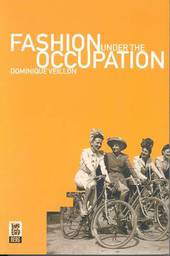
|
Fashion Under the Occupation
Paperback / softback
Main Details
| Title |
Fashion Under the Occupation
|
| Authors and Contributors |
Translated by Miriam Kochan
|
|
By (author) Dominique Veillon
|
| Physical Properties |
| Format:Paperback / softback | | Pages:224 | | Dimensions(mm): Height 234,Width 156 |
|
| Category/Genre | Fashion design and theory
Second world war |
|---|
| ISBN/Barcode |
9781859735480
|
| Classifications | Dewey:391.0094409044 |
|---|
| Audience | | General | | Professional & Vocational | |
|---|
| Illustrations |
illustrations, bibliography, index
|
|
Publishing Details |
| Publisher |
Bloomsbury Publishing PLC
|
| Imprint |
Berg Publishers
|
| Publication Date |
1 October 2002 |
| Publication Country |
United Kingdom
|
Description
Translated by Miriam Kochan Before the outbreak of WWII, French fashion represented the very pinnacle of style, and French women the epitome of chic. At home and abroad, couturiers wealthy clients eagerly awaited the latest collections, and design houses throughout the world looked to Paris for inspiration. Unparalleled for glamour and elegance, all things French were noted and emulated - and especially French fashion. One morning in September 1939, into this idyllic world of haute couture and Caf society came the shattering experience of war, followed by the German Occupation. French women, determined not to give way to the inevitable austerities, sought innovation: hats made from blotting paper or newspapers - the latter signalling political allegiances - and blouses made out of parachute silk, often obtained through dubious means. Not only did life go on, but creativity flourished - culottes, which enabled stylish bicycle journeys, became the vogue, and couturiers capitalized on deprivation with wit - dubbing designs Coal and Black Coffee, or naming an entire collection after Mtro stops. Fashion under the Occupation provides the only in-depth history of these blackest years in French history, long overlooked by fashion history because of the impoverished industry and deprivations that affected design. Widely acknowledged as the authoritative work on fashion during this period, it is available in English for the first time and will be essential reading for anyone interested in fashion, French cultural history, and particularly the German Occupation of France.
Author Biography
Dominique Veillon is Director of Research, Institut d'histoire du temps prsent, CNRS. Translated from the French by Miriam Kochan
Reviews'It is only now, with the publication, in Paris, of Dominique Veillons La Mode sous l'Occupation, that we learn how valiantly French womens impulse to express themselves in the clothes they wear adapted itself to their straightened lives, and how narrowly the French fashion industry escaped extinction.' The New Yorker 'This rich work (and good read) dedicated to a new subject, will enrich our knowledge of the war-time economy in a significant way.' Jean-Pierre Le Crom, H-France 'Her study is a highly accessible account of the legislative and political restrictions imposed by the Vichy regime on the fashion industry in France, particularly in Paris ... Veillon's study is rich in details of how the occupied population managed not just to clothe themselves but also to make cultural statements through their apparel.' Carole Sweeney, Journal of Romance Studies, Volume 3, Number 2, 2003 'Superb history of French fashion under German occupation... Veillon's masterful study... rendered in a lucid, faithful translation, succeeds in deploying the business of fashion to illuminate both high politics and everyday life under the Occupation.' Entreprise and Society 'Veillon's zestful account will challenge those who see World War II as comprising one reductive narrative, for it shows the full range of the historian's art and of history. Veillon explores the trivial and mean-spirited, the defiant and resourceful as they operated at a medium level during extraordinary times. This is the story neither of the depths of degradation nor of the heights of courage. That is, it takes place where most of history is spent and where there is nonetheless important meaning.' Bonnie G. Smith, Journal of Modern History, Vol 77, No 3, September 2005
|